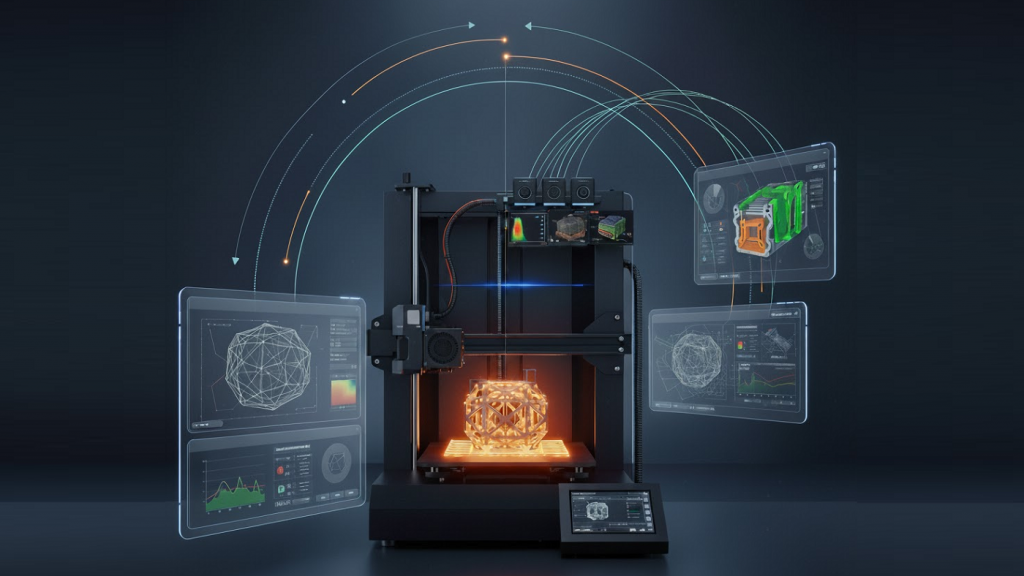Why Metrology Matters in Additive Manufacturing – Closing the Loop Between 3D Printing and Quality Verification
Metrology in additive manufacturing is the science of measuring and verifying parts produced through 3D printing to ensure they meet exact design specifications. In an era where tolerance can determine whether a component flies in an aircraft or fails under load, precision has become more than a goal; it’s a necessity. According to a 2024 ASTM study, over 40% of AM production delays are attributed to undetected dimensional errors or surface inconsistencies. That number highlights why measurement technologies have become an integral part of additive workflows.
Additive manufacturing has unlocked a world of complex geometries and lightweight designs, but these benefits come with new challenges in validation and repeatability. This article examines the importance of metrology in additive manufacturing, its role in providing real-time process feedback, and the emerging innovations that are bridging the gap between design, production, and inspection.
What Is Additive Manufacturing and Why Does Precision Matter?
Additive manufacturing is a production process that builds objects layer by layer from digital 3D models using materials such as polymers, metals, and composites. Because each layer contributes to the overall structure, precision directly affects strength, functionality, and dimensional accuracy.
Even the slightest deviation during layer deposition can lead to deformation or internal stress, resulting in parts failing before they are tested. That’s why metrology, defined as the science of measurement, is the backbone of quality assurance in AM. By monitoring tolerances and verifying geometries, manufacturers ensure that printed components behave exactly as designed. In other words, the bridge between digital intent and physical realization depends entirely on how well precision is measured and maintained.
What Is Metrology in Additive Manufacturing?
Metrology in additive manufacturing is the process of applying measurement science throughout the design, printing, and validation stages to confirm part quality. It integrates sensors, scanners, and analytical tools that verify critical dimensions and surface properties.
In the context of 3D printing, metrology ensures each printed layer matches the digital model’s intended geometry. It also enables traceability by collecting measurement data that supports certifications for industries such as aerospace and medical devices. From powder characterization to final part inspection, measurement is the thread connecting every phase of additive production.
How Does the Additive Manufacturing Process Create New Challenges for Measurement?
The additive process presents unique challenges for metrology due to its complexity and variability. Parts often feature internal channels, lattice structures, and organic shapes that traditional tools cannot easily measure.
Surface roughness caused by powder fusion, shrinkage during cooling, and uneven material deposition all introduce deviations that complicate dimensional verification. Moreover, high-resolution scans produce massive data sets that require advanced software to process efficiently.
As a result, engineers must rethink how they measure accuracy, not only after the print but also during the printing process. This shift has led to a growing demand for hybrid measurement technologies that can capture real-time feedback directly from the print chamber.
What Are the Main Metrology Techniques Used in Additive Manufacturing?
Metrology techniques in AM encompass both contact and non-contact systems designed to measure external and internal geometries with high precision. Each serves a different stage in the process chain, from powder validation to final inspection.
The most widely used techniques include:
Coordinate Measuring Machines (CMM): Use tactile probes to capture the dimensional accuracy of finished parts with micron-level precision.
Laser Scanning and Structured Light Scanning: Capture millions of surface data points to form detailed 3D maps for comparison against CAD models.
Computed Tomography (CT) Scanning: Enables full internal inspection to detect porosity, voids, or misaligned layers.
Optical and Confocal Microscopy: Measure surface finish, texture, and layer uniformity at the microscopic scale.
In-Situ Process Monitoring: Utilizes cameras, thermal sensors, and lasers to track part formation in real-time.
Each technique complements the others to create a complete quality assurance ecosystem, one that validates accuracy before, during, and after printing.
How Does In-Situ Metrology Work in 3D Printing Environments?
In-situ metrology operates directly within the additive manufacturing process to detect deviations as they occur. This approach relies on integrated sensors, cameras, and feedback systems that monitor variables such as temperature, laser power, and powder deposition rate.
When the system identifies an anomaly, it can automatically adjust parameters or alert the operator, preventing material waste and ensuring dimensional integrity. In-situ systems form the foundation of closed-loop manufacturing, where measurement data continuously guides process control.
Modern printer manufacturers, such as those offering industrial 3D printers for engineering applications, increasingly integrate this type of feedback system to help engineers achieve higher yield rates and better consistency across multiple builds.
What Are the Advantages of Integrating Metrology with Additive Manufacturing?
Integrating metrology with additive manufacturing delivers measurable benefits across the entire production workflow. It enhances part validation, accelerates time-to-market, and builds confidence in the reliability of 3D-printed components.
Here are five key advantages:
Improve Dimensional Accuracy: Detect and correct errors before they propagate through multiple layers.
Enable Faster Part Certification by Generating traceable inspection data for regulatory and industrial compliance.
Reduce Waste and Rework: Identify out-of-tolerance areas early to minimize scrap material and optimize production efficiency.
Support Predictive Maintenance: Use continuous data to anticipate machine wear or environmental drift.
Enhance Digital Traceability by Recording all measurements in unified databases for future audits or reprints.
The synergy between additive production and precision measurement is transforming how industries achieve repeatable, high-performance results.
What Are the Limitations or Disadvantages of Current Metrology in AM?
Despite its advantages, metrology integration in AM faces several hurdles that limit scalability and affordability.
The main disadvantages include:
High Cost of Equipment: Advanced scanners and CT systems represent significant capital investments.
Complex Data Interpretation: Gigabytes of inspection data require specialized software and expertise.
Limited Access to Internal Geometries: Large or dense metal parts pose a significant challenge even to the most advanced imaging technologies.
Need for Expert Operators: Skilled technicians are essential to ensure calibration and consistent results.
Until these challenges are mitigated through automation and cost reduction, small manufacturers may find full metrology integration financially restrictive.
How Can Metrology Close the Loop in Additive Manufacturing Quality Control?
Closing the loop involves utilizing metrology data to continuously refine and control the additive manufacturing process. In this system, every measurement informs the next production step, creating a feedback-driven cycle that minimizes the need for human intervention.
The loop typically involves four main stages:
Data Acquisition: Sensors capture measurements during or after the printing process.
Data Analysis: Software identifies deviations or patterns of error.
Process Correction: Machine parameters are adjusted in real time.
Validation: Measurements confirm that corrections restored accuracy.
This cycle forms the backbone of Industry 4.0 manufacturing, where automation, analytics, and inspection work in harmony to deliver parts that meet or exceed design intent.
Comparing Traditional Quality Verification vs. Additive Manufacturing Metrology
What changes with metrology in AM is not raw instrument accuracy. Tactile CMMs remain the gold standard for point accuracy, but AM-oriented optical or CT systems and in-situ monitoring provide denser data, faster, and can feed the printer while it is running.
| Parameter | Conventional QA (e.g., Gauges, CMM) | AM-Oriented Metrology (e.g., Laser, Structured Light, CT, In-Situ) |
| Measurement Type | Point or sparse sampling | Full-field or volumetric (millions of points) |
| Typical Uncertainty | Very low on probed features (often single-digit µm) | Low to moderate on full surfaces or volumes (tens of µm typical) |
| Coverage | External features, selected points | External and internal (via CT); entire surface or volume |
| Throughput | Slower; post-process | Faster; can be in-process or immediate post-build |
| Feedback timing | Reactive (after build) | Proactive or closed-loop (during build or right after) |
| Use-case fit | Final certification of critical dimensions | Monitoring, fast validation, and internal defect detection |
Why this matters: In additive manufacturing, metrology’s role shifts from ‘check it at the end’ to ‘steer it as you go.’ Even if a CMM achieves lower point uncertainty, AM-oriented scanning, CT, and in-situ monitoring provide richer data earlier and enable mid-build corrections. This is what moves QA from reactive inspection to proactive control.
How Do Standards and Certifications Support Metrology in Additive Manufacturing?
Standards define how quality and traceability should be maintained across different materials, machines, and industries. In additive manufacturing, compliance ensures that measurement results are consistent and verifiable worldwide.
Organizations such as ISO and ASTM have developed frameworks, including ISO/ASTM 52900, for terminology and process control. In the aerospace industry, AS9100 certification mandates the use of traceable metrology systems to validate flight-critical components. The National Institute of Standards and Technology (NIST) also contributes by creating calibration benchmarks for AM materials and instruments.
These efforts collectively help unify the language of measurement, enabling manufacturers to compare data and certify parts with confidence.
What Are the Key Applications of Metrology in Additive Manufacturing?
Metrology supports a wide range of applications in additive manufacturing, from research to full-scale production. Its influence extends across industries where precision is crucial for performance.
The five most common applications include:
Aerospace Part Qualification: Ensures flight hardware meets strict dimensional standards.
Medical Implant Verification: Confirms patient-specific implants fit perfectly before surgery.
Automotive Prototyping accelerates the design validation and testing process.
Energy and Turbine Inspection: Validates complex cooling channels in high-temperature components.
Material R&D: Enables researchers to study microstructures and porosity levels in experimental alloys.
Each application reinforces the critical link between metrology and product integrity.
How to Integrate Metrology into a 3D Printing Workflow
Integrating metrology into additive manufacturing requires a structured approach that ensures each step contributes to measurable improvement. The process can be divided into five main steps:
Identify Quality-Critical Features: Determine which dimensions or surfaces require verification to ensure quality.
Select Appropriate Measurement Technology: Match part geometry and material with the best scanning or probing system.
Calibrate Tools: Ensure all instruments are traceable to recognized standards and calibration protocols.
Perform Pre- and Post-Build Inspections: Validate powder uniformity, part orientation, and finished accuracy.
Feed Sata into a Feedback Loop: Use insights to adjust process parameters and maintain consistent output.
Companies offering manufacturing quality audit consulting often help implement such structured systems, ensuring data from metrology seamlessly integrates with quality management programs.
What Is the Future of Metrology in Additive Manufacturing?
The future of metrology in additive manufacturing lies in intelligent automation and digital interconnectivity. Artificial intelligence is now capable of interpreting scan data more quickly and accurately than human operators.
Digital twins, virtual replicas of parts and machines, are being used to simulate measurement and correction in real time. Meanwhile, cloud-based inspection platforms allow global teams to review and approve results instantly.
As systems evolve, measurement will become a silent partner in production, constantly working behind the scenes to ensure every printed part achieves its intended form and function.
Conclusion
Metrology is not an afterthought in additive manufacturing; it is its compass. It guides design, monitors production, and validates the outcome. By closing the loop between printing and verification, manufacturers gain the consistency and trust needed to scale AM beyond prototyping.
As measurement technologies continue to evolve, the vision of autonomous, self-correcting 3D printing lines is fast becoming a reality, reshaping how precision manufacturing defines success.
For more information: www.raise3d.com
AuthorL Ruben Nigaglioni – Business Development Representative at Raise3D








